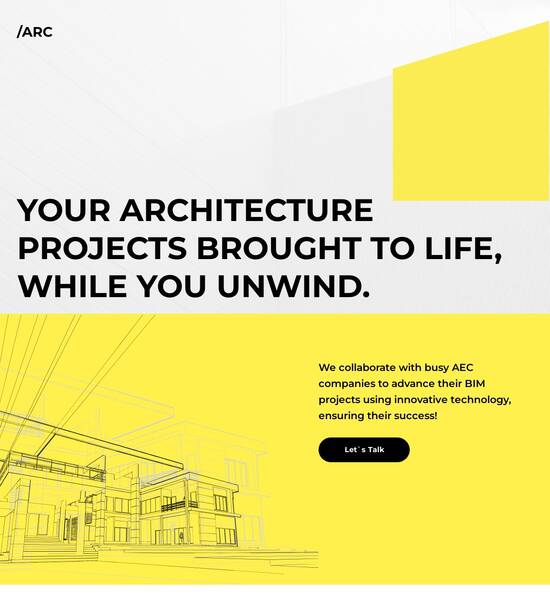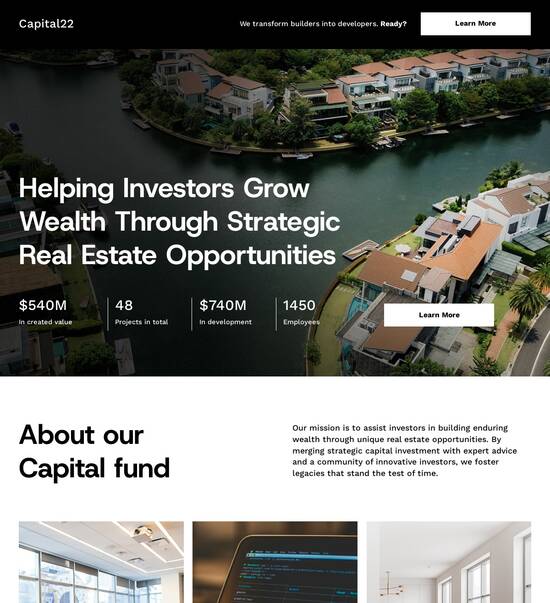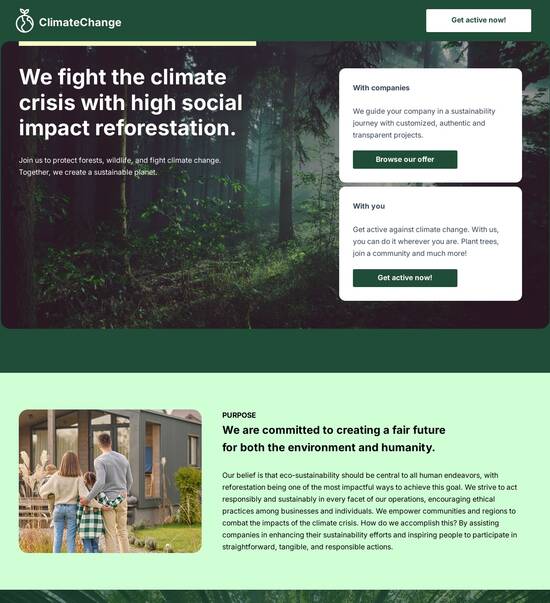
Modern 403 forbidden page template
Explore Similar TemplatesAbout template
Unleash your creativity with the modern 403 forbidden page template. Try Instapage today.
Recommended templates

Easy to build without coding
With the intuitive drag-and-drop builder, anyone on your team can create high-converting pages without any knowledge of code or design. Make enhancements to your landing page with custom widgets using Javascript, HTML/CSS, or third-party scripts.

Multiple layouts for any industry and goal
Select from 500+ landing page layouts built to boost conversions across industry-specific scenarios. Customize them by adjusting fonts, adding images, and generating on-brand content with the AI assistant. Quickly scale with Instablocks® and Global Blocks that you can save, reuse, and update globally.

Loads fast and looks polished on any device
Every template is responsive, which means they present professionally on any device and load blazingly fast with our Thor Render Engine. You can also power them up with Google AMP technology to deliver an unparalleled mobile experience and drive higher conversions.

Robust analytics & experimentation
Get real-time updates and reporting across all your devices, showing the number of visitors, conversions, cost-per-visitor, and cost-per-lead. Launch AI-powered experiments, run A/B tests, and use heatmaps to analyze user behavior, then optimize your landing page to maximize conversions.







Easy to build without coding
With the intuitive drag-and-drop builder, anyone on your team can create high-converting pages without any knowledge of code or design. Make enhancements to your landing page with custom widgets using Javascript, HTML/CSS, or third-party scripts.
Multiple layouts for any industry and goal
Select from 500+ landing page layouts built to boost conversions across industry-specific scenarios. Customize them by adjusting fonts, adding images, and generating on-brand content with the AI assistant. Quickly scale with Instablocks® and Global Blocks that you can save, reuse, and update globally.
Loads fast and looks polished on any device
Every template is responsive, which means they present professionally on any device and load blazingly fast with our Thor Render Engine.
Robust analytics & experimentation
Get real-time updates and reporting across all your devices, showing the number of visitors, conversions, cost-per-visitor, and cost-per-lead. Launch AI-powered experiments, run A/B tests, and use heatmaps to analyze user behavior, then optimize your landing page to maximize conversions.
All the features you need to build lead-generating landing pages
Explore more featuresLearn how to build top-performing landing pages for any goal
FAQs
Leading the way in building high-performing landing pages





Creating high-converting landing pages with Instapage
Building effective landing pages is crucial for boosting your digital marketing strategy. Instapage provides a powerful platform to create optimized landing pages tailored to your target audience, enabling you to drive conversions and maximize ROI.
Select the right template for your campaign
Choosing a high-converting template is the first step towards a successful landing page. Instapage offers over 100 professionally designed templates that cater to various industries like education, marketing, and financial services. Here’s how to select the best one for your needs:
- Understand your audience: Identify the specific needs and expectations of your target audience to select a template that resonates with them.
- Explore template categories: Instapage categorizes templates by industry and purpose. Explore these to find a suitable match.
- Test and experiment: Use A/B testing to determine which template drives the most conversions.
Customize your landing page elements
Personalization plays a significant role in enhancing user experience and improving conversion rates. Instapage allows you to tailor landing pages according to your audience's preferences. Here are some key customization tips:
- Use dynamic text replacement: Adjust your landing page content based on keywords from the ads that lead users to your page.
- Incorporate compelling visuals: Include high-quality images and videos that align with your branding and message.
- Add lead generation elements: Utilize forms, CTA buttons, and chat features to capture user information effectively.
Optimize for performance
Observing user interaction with your page is vital for continuous improvement. Instapage offers robust optimization tools such as heatmaps and analytics dashboards. Implement the following steps:
- Analyze user behavior: Use heatmaps to identify where users click the most and adjust your layout accordingly.
- Conduct A/B tests: Regularly test different versions of your landing page elements to find the highest-performing configurations.
- Monitor metrics: Keep track of key performance indicators (KPIs) to understand the overall effectiveness of your landing page.
By following these steps and utilizing Instapage's powerful features, you can enhance your landing pages significantly, tailoring and optimizing them for each marketing campaign.
In summary, crafting effective landing pages is a blend of good design, personalization, and optimization. Harness the power of Instapage to create impactfully.
Ready to take your landing page performance to the next level? Sign up for Instapage today and start building pages that convert.
People also ask about Modern 403 forbidden page template
Modern 403 Forbidden page template: Enhancing user experience through error design
Understanding the 403 Forbidden error: A user's perspective
When a user encounters a 403 Forbidden error, it can be a frustrating experience. This error means that the server understands the request, but it refuses to authorize it. It's important to note that the 403 status code is part of the HTTP protocol, which consists of various status codes indicating the outcome of a request. By understanding the implications of a 403 error, users can better navigate their online experiences and understand the boundaries of website access.
The implications of a 403 error can extend beyond mere annoyance. It disrupts the user experience and can lead to confusion or deter users from returning to the website. Awareness of the error signifies restricted content that the user is not permitted to view, which can impact perceptions of the website's accessibility and inclusivity.
Common reasons for access denied errors
Several factors can lead to encountering a 403 Forbidden error. One of the primary reasons is related to server permissions and configurations. For instance, incorrect file permissions on the server could prevent users from accessing certain resources. Additionally, server configurations may restrict access based on the user's IP address, which can trigger a 403 error unexpectedly.
User roles and settings can also contribute to the appearance of a 403 error. For example, websites with member-only content may restrict access based on user login status or subscription level. In such cases, users who are not logged in or lack the necessary permissions will encounter the 403 error message.
The importance of a modern 403 Forbidden page template
A well-designed error page holds significant value in the context of user engagement. Instead of letting a negative experience deter potential customers, a modern 403 Forbidden page can serve as a strategic opportunity to retain users. Engaging messages, creative visuals, and navigational tools can redirect frustrated users toward relevant content, potentially converting an error into a positive interaction.
Moreover, a thoughtfully designed error page can contribute to brand identity even when users face difficulties. Incorporating brand colors, typography, and logos into the 403 page ensures consistency across the website. When users align their experiences with recognizable branding, it helps in building trust and can enhance overall customer loyalty.
User experience and navigation
An essential aspect of a modern 403 Forbidden page template is its focus on user experience. Effective layouts provide clear messaging and easy navigation, guiding users away from the error. By presenting suggestions for alternative content, users can discover other features or sections of the website they might enjoy.
Strategies such as providing a search bar, links to popular sections, or displaying the latest blog posts can increase the likelihood of user retention. A seamless navigation experience transforms initial frustration into satisfaction, drawing users back rather than having them leave the site.
Key features of a modern 403 Forbidden page template
Customization is a vital feature for modern error pages. Users can tailor layouts to reflect their brand effectively. Customizable options often include integrating logos, choosing brand-specific colors, and selecting typography that aligns with the overall site theme. A template that allows for personalization can help reinforce the brand's identity, even at moments when users face obstacles.
Logos: Including the brand logo prominently enhances identity.
Colors: Using brand colors can create visual continuity.
Typography: Selecting fonts consistent with brand style reinforces familiarity.
Another essential aspect of a modern 403 Forbidden page template is the balance between simplicity and functionality. While the design should be unpretentious, rich content can still add value. Clear calls to action and navigational links will guide users to alternative pathways on the website. Ensuring that visitors can easily return to the main site or find valuable resources is crucial.
Responsive design is increasingly important for retaining users across devices. A modern template adapts seamlessly, whether on desktops, tablets, or mobile devices. Mobile optimization plays a significant role in user retention; if users encounter a convoluted or hard-to-navigate error page on their smartphones, they are less likely to return.
Crafting an engaging 403 error page template
Effective error page design comprises several mandatory components. Clear messaging should provide users with an understanding of the error, along with a visual element that aligns with the brand. Innovative elements like animations or user interaction opportunities can add a engaging touch, which keeps users interested rather than frustrated.
Compelling messaging: Clearly explain the error.
Visuals: Incorporate branding elements to maintain consistency.
Links: Provide clear and accessible navigation options.
Brand incorporation in error pages can be achieved without sacrificing clarity. Techniques include subtle branding within the design framework, ensuring that the error page doesn't overwhelm the user with information. Templates can utilize playful animations or illustrations that convey the error without taking away from the user's experience.
Real-life examples illustrate how successful branding reinforces the identity of a website. Companies that incorporate engaging narratives, visuals, or humor can create a memorable experience, leaving users with a positive impression of the brand—even when faced with restrictions.
Utilizing plugins and developer tools for customization
To enhance error page management, a variety of plugins are available for marketers and developers. These plugins often include additional functionalities that simplify the customization process. For instance, popular options like Elementor and Custom 404 Pro allow users to create tailored error pages using pre-designed templates without technical knowledge.
Elementor: A powerful tool for creating custom landing and error pages.
Custom 404 Pro: Specifically designed for optimizing error pages.
WP 404 Auto Redirect: Redirect options for managing user experience.
For developers interested in deeper customization, leveraging techniques like server-side scripting can create unique experiences. For instance, writing custom scripts in PHP can enable developers to show specific error messages based on the user's query or suggest tailored content that matches their previous activities.
Advanced users can explore API integrations to pull error page details dynamically, enhance user interaction, and provide personalized error responses. Custom coding, coupled with creativity, allows for the development of error pages that not only inform but also engage users in meaningful ways.
Analyzing case studies of successful 403 Forbidden pages
Examining high-traffic websites reveals effective strategies for error handling. Notable brands utilize their 403 Forbidden pages not just to inform users but also to guide them elsewhere. For example, websites like Dropbox and Twitter include links to help centers or user guides on their error pages, effectively minimizing confusion and keeping visitors engaged.
Analysis of visitor retention and engagement metrics post-redesign of error pages showcases significant improvements. Brands that approach error management as an opportunity for engagement rather than a drawback may see increased user satisfaction and a decline in bounce rates.
What not to do: Common mistakes in error page design
Common pitfalls in error page design include reliance on generic templates and inadequate user guidance. When brands opt for a cookie-cutter approach, it detracts from the user experience and can increase frustration. Minimizing user assistance, such as failing to provide navigational links or suggestions, can create confusion and lead to negative perceptions of the brand.
Failure to convey the severity of the error appropriately may also diminish the user's understanding of the situation. This lack of insight can lead users to abandon the site entirely, impacting long-term engagement and trust. By highlighting these mistakes, brands can take corrective measures to create more effective error pages.
Future trends in error page design
The future of error page design may be heavily influenced by innovative technologies like artificial intelligence. With AI, businesses could deliver personalized error messages based on user behavior, preferences, and demographics. Such individualized experiences can enhance user engagement and satisfaction.
Dynamic content may also play a significant role in evolving standards for error pages. Rather than displaying static messages, brands can leverage real-time data to provide tailored suggestions, resources, or even updated site status to users encountering a 403 Forbidden error.
The evolving standards for digital communication
As user expectations continue to evolve, businesses will need to reassess their approach to error messaging. Standards for clarity, accessibility, and brand representation will redefine error pages in the coming years. Marketers and developers alike must prioritize user experience when crafting their 403 Forbidden pages, ensuring that every element serves to inform, engage, and reassure users.
Practical steps to implementing a modern 403 Forbidden page template
To effectively enhance your current error page setup, start by assessing its performance. Key indicators such as user feedback and analytics data will help identify areas needing improvement. Engaging users in providing feedback about their error encounters can yield crucial insights to refine your 403 page.
Collect user feedback: Understand frustration points.
Analyze data: Look for patterns in user behavior.
Set improvement goals: Structuring a clear plan will guide changes.
Implementing changes based on user feedback loops ensures the error page remains agile and user-centric. Continuous iteration allows you to tailor the error experience as user behaviors evolve. Incorporating methods for soliciting user input post-error encounter creates an adaptive design.
Incorporating feedback mechanisms, such as quick surveys after an error, ensures voices are heard. By taking a proactive approach to error management, brands can continually refine their user experience, ultimately driving better engagement and reducing user frustration.
Conclusion: The transformative power of a thoughtfully designed 403 Forbidden page
Summarizing the essential takeaways from crafting a modern 403 Forbidden page highlights the importance of user experience, branding, and retention. Every detail, from design to messaging, contributes to the overall impact on the user's journey.
Investing in quality error pages is a strategy with long-term benefits. By embracing an approach that prioritizes user engagement through well-crafted 403 pages, brands can enhance trust, increase customer loyalty, and boost conversion rates over time, even amid adverse situations.
Ready to skyrocket conversions?
Supercharge your ad campaigns with high-performing landing pages
Get started














